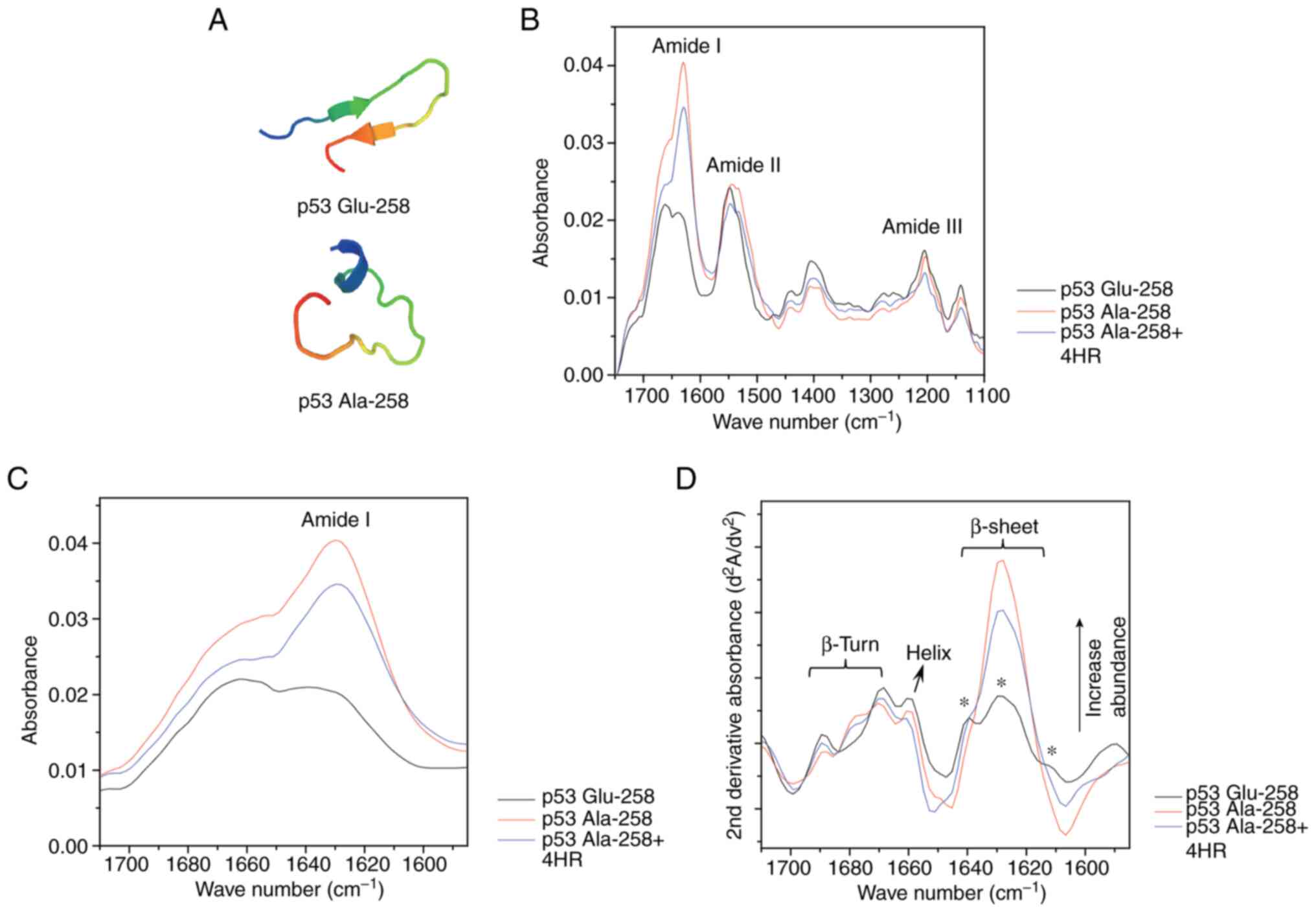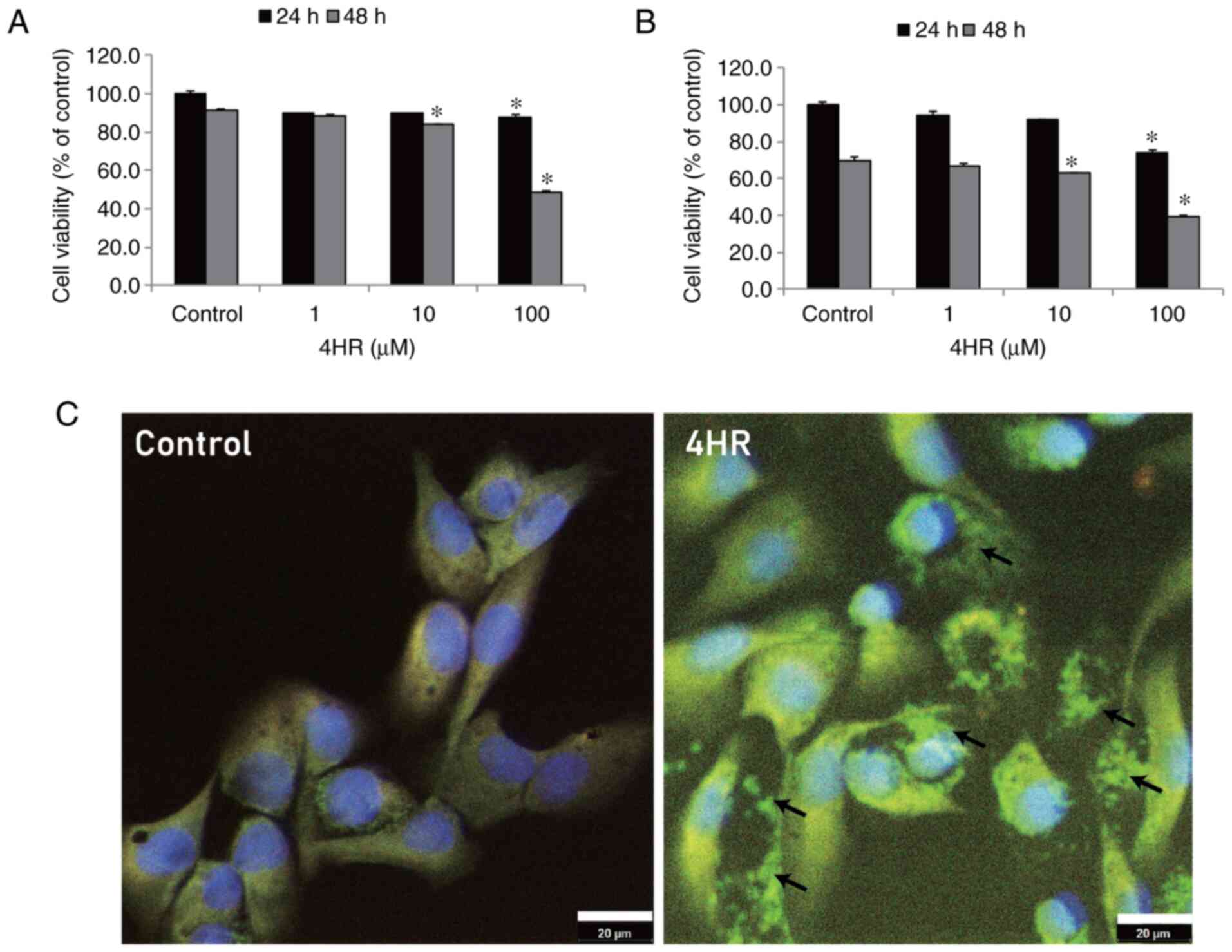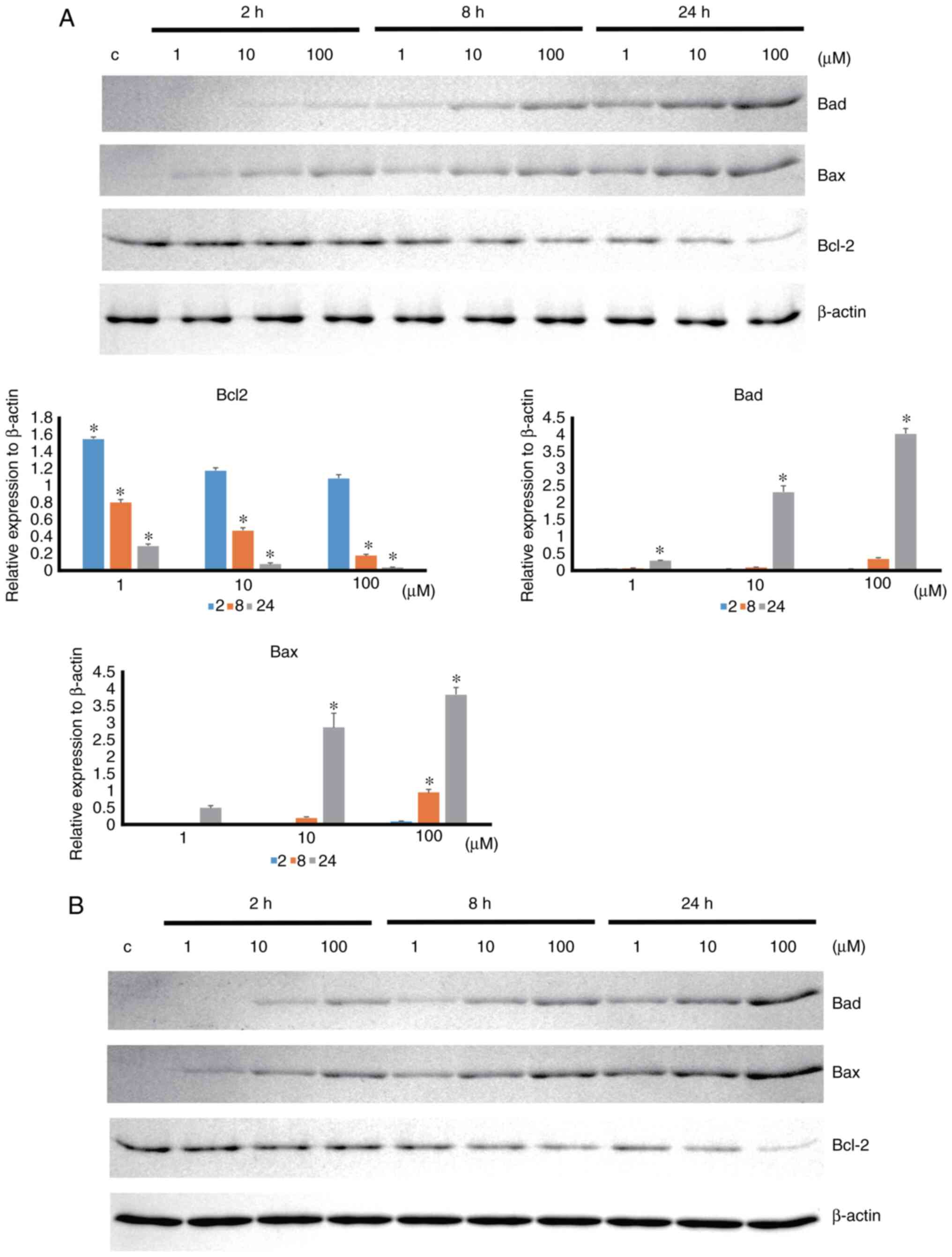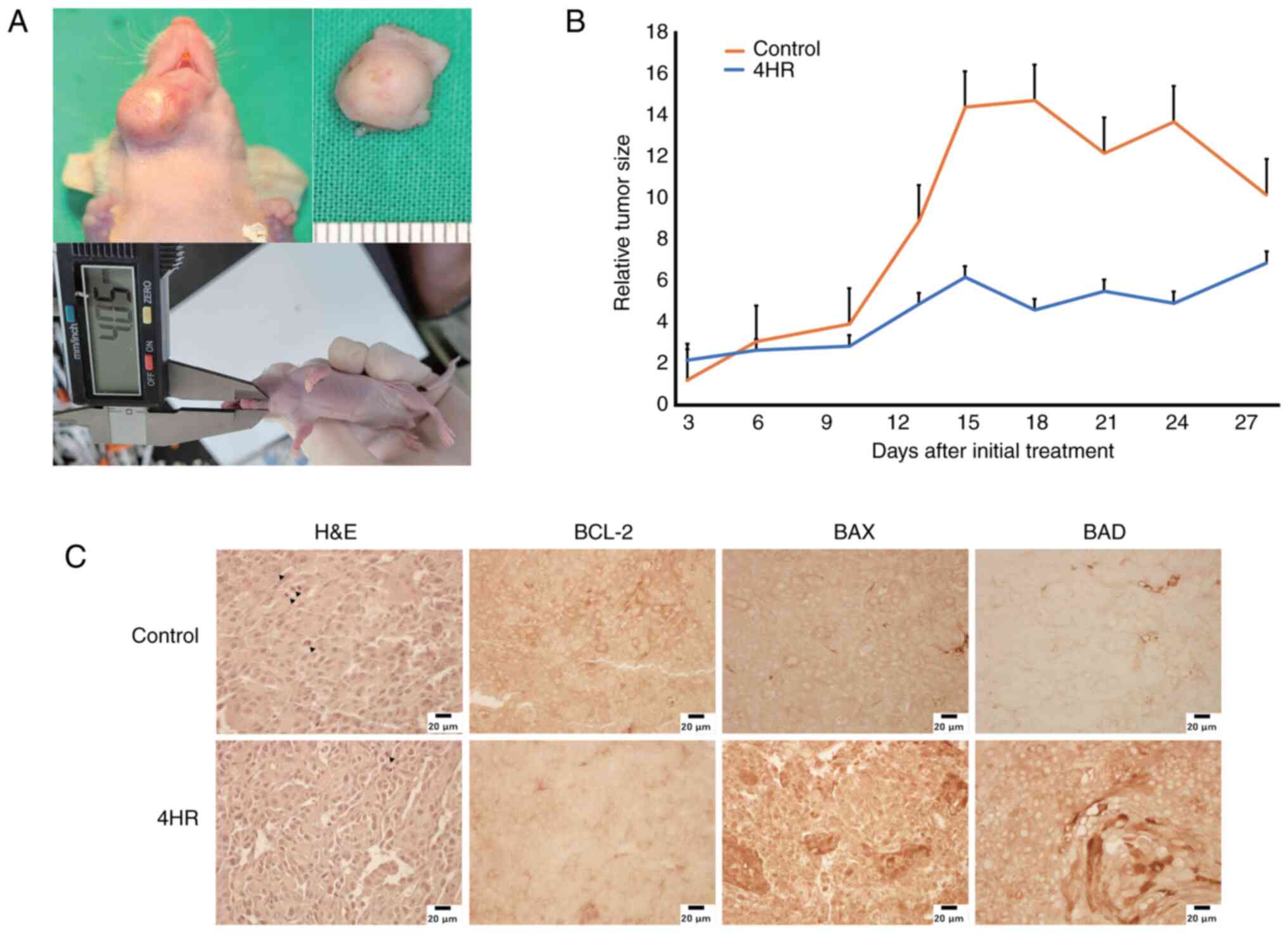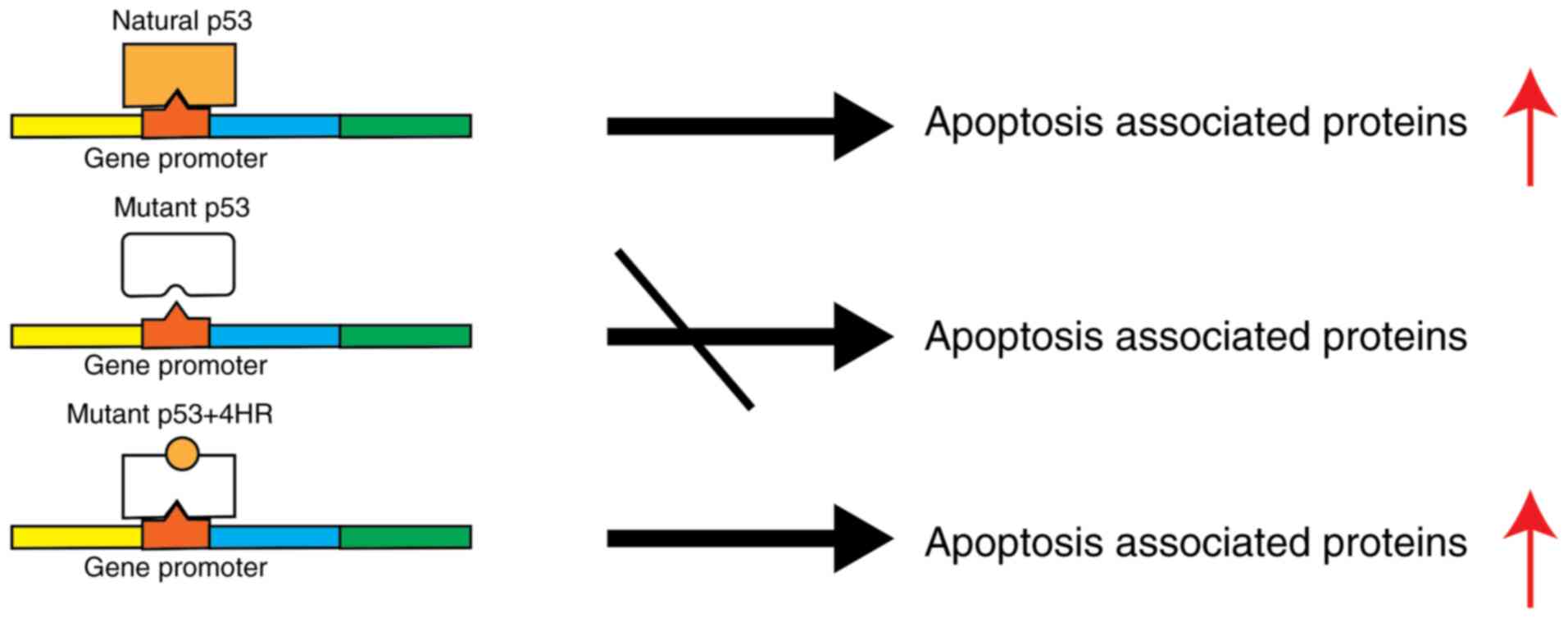|
1
|
Lane DP: Cancer. p53, guardian of the
genome. Nature. 358:15–16. 1992. View
Article : Google Scholar : PubMed/NCBI
|
|
2
|
Levine AJ: p53, the cellular gatekeeper
for growth and division. Cell. 88:323–331. 1997. View Article : Google Scholar
|
|
3
|
Xia Z, Kon N, Gu AP, Tavana O and Gu W:
Deciphering the acetylation code of p53 in transcription regulation
and tumor suppression. Oncogene. 41:3039–3050. 2022. View Article : Google Scholar : PubMed/NCBI
|
|
4
|
Pecorino L: Molecular biology of Cancer.
Oxford University Press; Oxford: 2016
|
|
5
|
Lee JH, Kim HS, Lee SJ and Kim KT:
Stabilization and activation of p53 induced by Cdk5 contributes to
neuronal cell death. J Cell Sci. 120:2259–2271. 2007. View Article : Google Scholar
|
|
6
|
Brooks CL and Gu W: Ubiquitination,
phosphorylation and acetylation: The molecular basis for p53
regulation. Curr Opin Cell Biol. 15:164–171. 2003. View Article : Google Scholar
|
|
7
|
Peltonen JK, Helppi HM, Pääkkö P,
Turpeenniemi-Hujanen T and Vähäkangas KH: p53 in head and neck
cancer: Functional consequences and environmental implications of
TP53 mutations. Head Neck Oncol. 2:362010. View Article : Google Scholar
|
|
8
|
Lindemann A, Takahashi H, Patel A, Osman A
and Myers J: Targeting the DNA damage response in OSCC with TP 53
mutations. J Dent Res. 97:635–644. 2018. View Article : Google Scholar : PubMed/NCBI
|
|
9
|
de Bakker T, Journe F, Descamps G, Saussez
S, Dragan T, Ghanem G, Krayem M and Van Gestel D: Restoring p53
function in head and neck squamous cell carcinoma to improve
treatments. Front Oncol. 11:7999932022. View Article : Google Scholar
|
|
10
|
Kaida A and Iwakuma T: Regulation of p53
and cancer signaling by heat shock protein 40/J-domain protein
family members. Int J Mol Sci. 22:135272021. View Article : Google Scholar
|
|
11
|
Kanapathipillai M: Treating p53 mutant
aggregation-associated cancer. Cancers (Basel). 10:1542018.
View Article : Google Scholar
|
|
12
|
Muller PA and Vousden KH: Mutant p53 in
cancer: New functions and therapeutic opportunities. Cancer Cell.
25:304–317. 2014. View Article : Google Scholar
|
|
13
|
Lee EJ, Kim J, Lee SA, Kim EJ, Chun YC,
Ryu MH and Yook JI: Characterization of newly established oral
cancer cell lines derived from six squamous cell carcinoma and two
mucoepidermoid carcinoma cells. Exp Mol Med. 37:379–390. 2005.
View Article : Google Scholar : PubMed/NCBI
|
|
14
|
Lambert JM, Gorzov P, Veprintsev DB,
Söderqvist M, Segerbäck D, Bergman J, Fersht AR, Hainaut P, Wiman
KG and Bykov VJ: PRIMA-1 reactivates mutant p53 by covalent binding
to the core domain. Cancer Cell. 15:376–388. 2009. View Article : Google Scholar
|
|
15
|
Chen HM, Lee YH and Wang YJ: ROS-triggered
signaling pathways involved in the cytotoxicity and tumor promotion
effects of pentachlorophenol and tetrachlorohydroquinone. Chem Res
Toxicol. 28:339–350. 2015. View Article : Google Scholar
|
|
16
|
Kim SG: 4-Hexylresorcinol: Pharmacologic
chaperone and its application for wound healing. Maxillofac Plast
Reconstr Surg. 44:52022. View Article : Google Scholar : PubMed/NCBI
|
|
17
|
Lee IS, Chang JH, Kim DW, Kim SG and Kim
TW: The effect of 4-hexylresorinol administration on NAD+ level and
SIRT activity in Saos-2 cells. Maxillofac Plast Reconstr Surg.
43:392021. View Article : Google Scholar : PubMed/NCBI
|
|
18
|
Kim JY, Kweon HY, Kim DW, Choi JY and Kim
SG: 4-Hexylresorcinol inhibits class I histone deacetylases in
human umbilical cord endothelial cells. Appl Sci. 11:34862021.
View Article : Google Scholar
|
|
19
|
Kim DW, Jo YY, Garagiola U, Choi JY, Kang
YJ, Oh JH and Kim SG: Increased level of vascular endothelial
growth factors by 4-hexylresorcinol is mediated by transforming
growth factor-β1 and accelerates capillary regeneration in the
burns in diabetic animals. Int J Mol Sci. 21:34732020. View Article : Google Scholar
|
|
20
|
Jiménez-Uribe AP, Gómez-Sierra T,
Aparicio-Trejo OE, Orozco-Ibarra M and Pedraza-Chaverri J:
Backstage players of fibrosis: NOX4, mTOR, HDAC, and S1P;
companions of TGF-β. Cell Signal. 87:1101232021. View Article : Google Scholar
|
|
21
|
Kim SG, JeonG JH, Park YW, Song JY, Kim
AS, Choi JY and Chae WS: 4-Hexylresorcinol inhibits
transglutaminase-2 activity and has synergistic effects along with
cisplatin in KB cells. Oncol Rep. 25:1597–1602. 2011.PubMed/NCBI
|
|
22
|
Kim SG, Lee SW, Park YW, Jeong JH and Choi
JY: 4-hexylresorcinol inhibits NF-κB phosphorylation and has a
synergistic effect with cisplatin in KB cells. Oncol Rep.
26:1527–1532. 2011.PubMed/NCBI
|
|
23
|
Xue L, Zhou B, Liu X, Qiu W, Jin Z and Yen
Y: Wild-type p53 regulates human ribonucleotide reductase by
protein-protein interaction with p53R2 as well as hRRM2 subunits.
Cancer Res. 63:980–986. 2003.PubMed/NCBI
|
|
24
|
Luo J, Su F, Chen D, Shiloh A and Gu W:
Deacetylation of p53 modulates its effect on cell growth and
apoptosis. Nature. 408:377–381. 2000. View
Article : Google Scholar : PubMed/NCBI
|
|
25
|
Zhang Y, Dong Y, Wu X, Lu Y, Xu Z, Knapp
A, Yue Y, Xu T and Xie Z: The mitochondrial pathway of anesthetic
isoflurane-induced apoptosis. J Biol Chem. 285:4025–4037. 2010.
View Article : Google Scholar : PubMed/NCBI
|
|
26
|
Shen Y, Maupetit J, Derreumaux P and
Tufféry P: Improved PEP-FOLD approach for peptide and miniprotein
structure prediction. J Chem Theory Comput. 10:4745–4758. 2014.
View Article : Google Scholar
|
|
27
|
Thévenet P, Shen Y, Maupetit J, Guyon F,
Derreumaux P and Tufféry P: PEP-FOLD: An updated de novo structure
prediction server for both linear and disulfide bonded cyclic
peptides. Nucleic Acids Res. 40:(Web Server Issue). W288–W293.
2012. View Article : Google Scholar
|
|
28
|
Kong J and Yu S: Fourier transform
infrared spectroscopic analysis of protein secondary structures.
Acta Biochim Biophys Sin (Shanghai). 39:549–559. 2007. View Article : Google Scholar : PubMed/NCBI
|
|
29
|
Jo YY, Kweon H, Kim DW, Baek K, Kim MK,
Kim SG, Chae WS, Choi JY and Rotaru H: Bone regeneration is
associated with the concentration of tumour necrosis factor-α
induced by sericin released from a silk mat. Sci Rep. 7:155892017.
View Article : Google Scholar : PubMed/NCBI
|
|
30
|
Jo YY, Kweon H, Kim DW, Baek K, Chae WS,
Kang YJ, Oh JH, Kim SG and Garagiola U: Silk sericin application
increases bone morphogenic protein-2/4 expression via a toll-like
receptor-mediated pathway. Int J Biol Macromol. 190:607–617. 2021.
View Article : Google Scholar
|
|
31
|
Buonocore G, Perrone S and Tataranno ML:
Oxygen toxicity: Chemistry and biology of reactive oxygen species.
Int J Biol Macromol. 15:186–190. 2010.
|
|
32
|
Yen GC, Duh PD and Lin CW: Effects of
resveratrol and 4-hexylresorcinol on hydrogen peroxide-induced
oxidative DNA damage in human lymphocytes. Free Radic Res.
37:509–514. 2003. View Article : Google Scholar : PubMed/NCBI
|
|
33
|
Guandalini E, Ioppolo A, Mantovani A,
Stacchini P and Giovannini C: 4-Hexylresorcinol as inhibitor of
shrimp melanosis: Efficacy and residues studies; evaluation of
possible toxic effect in a human intestinal in vitro model
(Caco-2); preliminary safety assessment. Food Addit Contam.
15:171–180. 1998. View Article : Google Scholar : PubMed/NCBI
|
|
34
|
Synnott NC, O'Connell D, Crown J and Duffy
MJ: COTI-2 reactivates mutant p53 and inhibits growth of
triple-negative breast cancer cells. Breast Cancer Res Treat.
179:47–56. 2020. View Article : Google Scholar
|
|
35
|
Lindemann A, Patel AA, Silver NL, Tang L,
Liu Z, Wang L, Tanaka N, Rao X, Takahashi H, Maduka NK, et al:
COTI-2, a novel thiosemicarbazone derivative, exhibits antitumor
activity in HNSCC through p53-dependent and-independent mechanisms.
Clin Cancer Res. 25:5650–5662. 2019. View Article : Google Scholar : PubMed/NCBI
|
|
36
|
Gao L, Yu L, Li CM, Li Y, Jia BL and Zhang
B: Karyopherin α2 induces apoptosis in tongue squamous cell
carcinoma CAL-27 cells through the p53 pathway. Oncol Rep.
35:3357–3362. 2016. View Article : Google Scholar : PubMed/NCBI
|
|
37
|
Lee IS, Kim DW, Oh JH, Lee SK, Choi JY,
Kim SG and Kim TW: Effects of 4-hexylresorcinol on craniofacial
growth in rats. Int J Mol Sci. 22:89352021. View Article : Google Scholar
|
|
38
|
Kim JY, Kim DW, Lee SK, Choi JY, Che X,
Kim SG and Garagiola U: Increased expression of TGF-β1 by
4-hexylresorcinol is mediated by endoplasmic reticulum and
mitochondrial stress in human umbilical endothelial vein cells.
Appl Sci. 11:91282021. View Article : Google Scholar
|
|
39
|
Hori M, Suzuki K, Udono MU, Yamauchi M,
Mine M, Watanabe M, Kondo S and Hozumi Y: Establishment of
ponasterone A-inducible the wild-type p53 protein-expressing clones
from HSC-1 cells, cell growth suppression by p53 expression and the
suppression mechanism. Arch Dermatol Res. 301:631–646. 2009.
View Article : Google Scholar : PubMed/NCBI
|
|
40
|
Kashiwazaki H: Detectability and
diagnostic criteria of p53 gene mutations in human oral squamous
cell carcinoma using yeast functional assay. Hokkaido Igaku Zasshi.
72:211–224. 1997.(In Japanese).
|
|
41
|
Ichwan SJ, Yamada S, Sumrejkanchanakij P,
Ibrahim-Auerkari E, Eto K and Ikeda MA: Defect in serine 46
phosphorylation of p53 contributes to acquisition of p53 resistance
in oral squamous cell carcinoma cells. Oncogene. 25:1216–1224.
2006. View Article : Google Scholar : PubMed/NCBI
|















